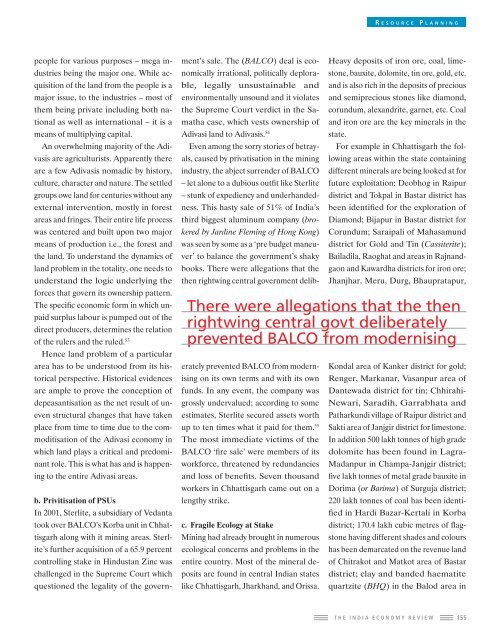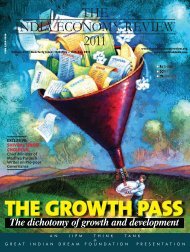Download - The India Economy Review
Download - The India Economy Review
Download - The India Economy Review
You also want an ePaper? Increase the reach of your titles
YUMPU automatically turns print PDFs into web optimized ePapers that Google loves.
people for various purposes – mega in-<br />
dustries being the major one. While ac-<br />
quisition of the land from the people is a<br />
major issue, to the industries – most of<br />
them being private including both na-<br />
tional as well as international – it is a<br />
means of multiplying capital.<br />
An overwhelming majority of the Adi-<br />
vasis are agriculturists. Apparently there<br />
are a few Adivasis nomadic by history,<br />
culture, character and nature. <strong>The</strong> settled<br />
groups owe land for centuries without any<br />
external intervention, mostly in forest<br />
areas and fringes. <strong>The</strong>ir entire life process<br />
was centered and built upon two major<br />
means of production i.e., the forest and<br />
the land. To understand the dynamics of<br />
land problem in the totality, one needs to<br />
understand the logic underlying the<br />
forces that govern its ownership pattern.<br />
<strong>The</strong> specifi c economic form in which unpaid<br />
surplus labour is pumped out of the<br />
direct producers, determines the relation<br />
of the rulers and the ruled. 53<br />
Hence land problem of a particular<br />
area has to be understood from its historical<br />
perspective. Historical evidences<br />
are ample to prove the conception of<br />
depeasantisation as the net result of uneven<br />
structural changes that have taken<br />
place from time to time due to the commoditisation<br />
of the Adivasi economy in<br />
which land plays a critical and predominant<br />
role. This is what has and is happening<br />
to the entire Adivasi areas.<br />
b. Privitisation of PSUs<br />
In 2001, Sterlite, a subsidiary of Vedanta<br />
took over BALCO’s Korba unit in Chhattisgarh<br />
along with it mining areas. Sterlite’s<br />
further acquisition of a 65.9 percent<br />
controlling stake in Hindustan Zinc was<br />
challenged in the Supreme Court which<br />
questioned the legality of the govern-<br />
ment’s sale. <strong>The</strong> (BALCO) deal is economically<br />
irrational, politically deplorable,<br />
legally unsustainable and<br />
environmentally unsound and it violates<br />
the Supreme Court verdict in the Samatha<br />
case, which vests ownership of<br />
Adivasi land to Adivasis. 54<br />
Even among the sorry stories of betrayals,<br />
caused by privatisation in the mining<br />
industry, the abject surrender of BALCO<br />
– let alone to a dubious outfi t like Sterlite<br />
– stunk of expediency and underhandedness.<br />
This hasty sale of 51% of <strong>India</strong>’s<br />
third biggest aluminum company (brokered<br />
by Jardine Fleming of Hong Kong)<br />
was seen by some as a ‘pre budget maneuver’<br />
to balance the government’s shaky<br />
books. <strong>The</strong>re were allegations that the<br />
then rightwing central government delib-<br />
erately prevented BALCO from modernising<br />
on its own terms and with its own<br />
funds. In any event, the company was<br />
grossly undervalued; according to some<br />
estimates, Sterlite secured assets worth<br />
up to ten times what it paid for them. 55<br />
<strong>The</strong> most immediate victims of the<br />
BALCO ‘fi re sale’ were members of its<br />
workforce, threatened by redundancies<br />
and loss of benefi ts. Seven thousand<br />
workers in Chhattisgarh came out on a<br />
lengthy strike.<br />
c. Fragile Ecology at Stake<br />
Mining had already brought in numerous<br />
ecological concerns and problems in the<br />
entire country. Most of the mineral deposits<br />
are found in central <strong>India</strong>n states<br />
like Chhattisgarh, Jharkhand, and Orissa.<br />
R ESOURCE PLANNING<br />
Heavy deposits of iron ore, coal, limestone,<br />
bauxite, dolomite, tin ore, gold, etc.<br />
and is also rich in the deposits of precious<br />
and semiprecious stones like diamond,<br />
corundum, alexandrite, garnet, etc. Coal<br />
and iron ore are the key minerals in the<br />
state.<br />
For example in Chhattisgarh the following<br />
areas within the state containing<br />
different minerals are being looked at for<br />
future exploitation: Deobhog in Raipur<br />
district and Tokpal in Bastar district has<br />
been identifi ed for the exploration of<br />
Diamond; Bijapur in Bastar district for<br />
Corundum; Saraipali of Mahasamund<br />
district for Gold and Tin (Cassiterite);<br />
Bailadila, Raoghat and areas in Rajnandgaon<br />
and Kawardha districts for iron ore;<br />
Jhanjhar, Meru, Durg, Bhaupratapur,<br />
<strong>The</strong>re were allegations that the then<br />
rightwing central govt deliberately<br />
prevented BALCO from modernising<br />
Kondal area of Kanker district for gold;<br />
Renger, Markanar, Vasanpur area of<br />
Dantewada district for tin; Chhirahi-<br />
Newari, Saradih, Garrabhata and<br />
Patharkundi village of Raipur district and<br />
Sakti area of Janjgir district for limestone.<br />
In addition 500 lakh tonnes of high grade<br />
dolomite has been found in Lagra-<br />
Madanpur in Champa-Janjgir district;<br />
fi ve lakh tonnes of metal grade bauxite in<br />
Dorima (or Barima) of Surguja district;<br />
220 lakh tonnes of coal has been identifi<br />
ed in Hardi Bazar-Kertali in Korba<br />
district; 170.4 lakh cubic metres of fl agstone<br />
having different shades and colours<br />
has been demarcated on the revenue land<br />
of Chitrakot and Matkot area of Bastar<br />
district; clay and banded haematite<br />
quartzite (BHQ) in the Balod area in<br />
THE INDIA ECONOMY REVIEW<br />
155





